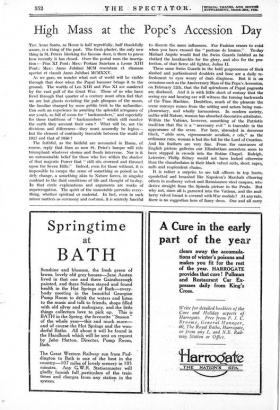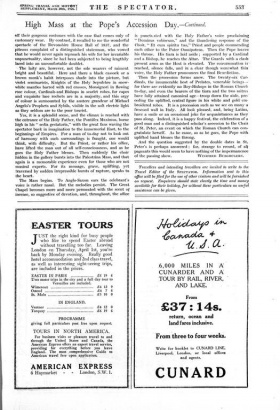High Mass at the Pope's Accession Day
Tan Anno Santo, as Rome is half regretfully, half thankfully aware, is a thing of the past. The fresh plaster, the only new thing in St. Peters blocking the famous door, is there to prove how recently it has closed. Over the portal runs the inscrip- tion :—Pius XI Pont: Max: Portam Sanctam, a Leone XIII Pont : Max : Anno Jubilaei MCM reseratam et clausam aperiut et clausit Anno Jubilaei MCMXXV.
As we gaze, we wonder what sort of world will be visible through that door when the Papal hammer brings it to the ground. The worlds of Leo XIII and Pius XI are sundered by the vast gulf of the .Great War. Those of us who have lived through that quarter of a century must often feel that we are but ghosts revisiting the pale glimpses of the moon, the familiar changed by some goblin trick to the unfamiliar. Can such an experience be awaiting the splendid arrogance of our youth, so full of scorn for " backnumbers," and especially for those traditions of " backnumbers " which still cumber the earth they account their own ? What will be, not the divisions and differences—they must assuredly be legion— but the element of continuity traceable between the world of 1925 and that of 1950 ?
The faithful, as the faithful are accounted in Rome, of course, reply that then as now St. Peter's barque will ride triumphant, whatever storms and floods intervene. Nor is it an unreasonable belief for those who live within the shadow of that majestic Power that " still sits crowned and throned upon the Seven Hills." Indeed, even for those without, it is impossible to escape the sense of something so poised as to defy change, a something akin to Nature forces, in singular contrast to the fluid conditions of life and thought of to-day. In that circle explanations and arguments are works of supererogation. The spirit of the immutable pervades every- thing, whether spiritual or material. In fact, even in such minor matters as ceremony and costume, it is scarcely fanciful
to discern the same influences. For Fashion ceases to exist when you have crossed the " portone de bronzo." To-day Michael Angelo would find the. Swiss Guards habited as he clothed the .lanzknechts for the glory, and also for the pro- tection, of that fierce old fighter, Julius II.
These same Swiss Guards in the bold gorgeousness of their slashed and particoloured doublets and hose are a daily re- freshment to eyes weary of drab dinginess. But it is on occasions such as the Anniversary Mass of the Pope's Accession, on February 12th, that the full splendours of. Papal pageants are disclosed. And it is with little short of ecstasy that the seeing eye and hearing ear will witness the turning backwards of the Time Machine. Doubtless, much of the pleasure the scene conveys comes from the setting and actors being com- plementary, and wholly harmonious. In_ modern society, unlike wild Nature, woman has absorbed decorative attributes. Within the. Vatican; however, something of the Patristic tradition that She is a " necessary evil " is traceable in the appearance of. the sexes.. For here, shrouded in decorous black, " abito nero, rigorosamente accollato, e veto," as the ordinance runs, woman is but the foil for the Lord of Creation. And his feathers are very . fine. From the canvasses of English picture galleries our Elizabethan ancestors seem to have stepped in crowds into the Sistine Chapel; Raleigh, Leicester, Philip. Sidney would not. have looked otherwise than the chamberlains in their black velvet suits, short capes, ruffs and resplendent chains.
It is rather a surprise. to .see tall officers in top boots, epauletted and besashed like Napoleon's Marshals elbowing others in mulberry _velvet and_ Renaissance steel calques, who derive straight from the Spinola picture in the Prado. But why not, since all is garnered into the Vatican,. and the_mul- berry velvet breast is covered with War medals ? At any rate, there is no suggestion here of fancy dress. One and all carry
High Mass at the Pope's Accession Day.—Continued.
off their gorgeous costumes with the ease that comes only of customary wear. By contrast, it recalled to me the wonderful spectacle of the 'Devonshire House Ball 'of 1897, and the piteous complaint of a distinguished statesman, who vowed that he would never again reproach his wife for her invariable unpunetuality, since he had been subjected to being lengthily laced into an uncomfortable doublet.
The laity are, however, not the sole wearers of raiment bright and beautiful. - Here and there a black cassock or a brown monk's habit interposes shade into the picture, but violet seminarists, Knights of the Holy Sepulchre in snow- white mantles barred with red crosses, Monsignori in flowing rose colour, Cardinals and Bishops in scarlet robes, fur capes and exquisite lace rochets are in a majority, and this orgy of colour is surmounted by the austere grandeur of Michael Angelo's Prophets and Sybils, visible in the soft electric light as they seldom are to the poor tourist.
Yes, it is a splendid scene, and the climax is reached with• the entrance of the Holy Father, the Pontifex Maximus, borne high in his " sedia gestatoria," with the great fans waving the spectator back in imagination to the immemorial East, to the beginnings of Empires. For a man of to-day not to look out of harmony with such surroundings is fraught, one would think, with difficulty. But the Priest, or rather his office, have lifted the man 'out of all self-consciousness, and as he goes the Holy Father blesses. Then suddenly the choir hidden in the gallery bursts into the Palestrina Mass, and that again is a memorable experience even for those who are not musical experts. For its message, grave, uplifting, yet traversed by sudden irrepressible bursts of rapture, speaks to the heart.
The Mass begins. To Anglo-Saxon ears the 'celebrant's voice is rather nasal. But the melodies persist. The Great Chapel becomes more and more permeated with the scent of incense, so suggestive of devotion, and, throughout, the office is punctuated with the Holy Father's voice proclaiming " Dominus vobiscum," and the thundering response of the
Choir, " Et cum spiritu tuo,"-Priest and people commending each other to the Pater Omnipotens. Then the Pope leaves his throne. His tiara is laid aside ; supported by a Cardinal and a Bishop, he reaches the Altar. The Guards with a clash present arms as the Host is elevated. The consummation is- reached, silence falls, and in a clear though 'somewhat thin' voice, the Holy Father pronounces the final Benediction.
Then the procession forms anew. The twenty-six Car- dinals, the innumerable host of Prelates, venerable beings—' for there are evidently no Boy-Bishops 'in the Roman Church to-day, and even the bearers of the tiara and the two mitres have fully attained canonical age—troop down the aisle, pre-' ceding the uplifted, central figure in his white and gold 'em• broidered robes. It is a procession such as we see on many a frescoed wall in Italy. All look pleased, and, being Latins, have a smile or an occasional joke for acquaintances as they pass along. Indeed, it is a happy festival, the celebration of a good man and a distinguished scholar's accession to the Chair of St.. Peter, an event on which the Roman Church can con- gratulate herself. As he came, so as he goes, the Pope with uplifted hand blesses the throng.
And the question suggested by the double dates in St. Peter's is perhaps answered ; for, strange to record, of all" pageants this would seem to have nothing of the impermanence



























































 Previous page
Previous page